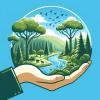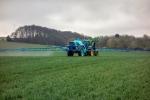H2020 Fiware4Water Project: FIWARE for Next Generation Internet Services for the WATER sector
- Type Project
- Status Filled
- Execution 2019 -2022
- Assigned Budget 4.997.945,00 €
- Scope Europeo
- Main source of financing Horizon 2020
- Project website Proyecto Fiware4Water
The Fiware4Water project seeks to replicate success stories by connecting the water sector with FIWARE, an open-source computing platform created in 2011 within the framework of the Public-Private Partnership for the Future Internet, funded by the European Commission. Connecting the water sector to the FIWARE platform will contribute to the implementation of innovative digital solutions. In particular, it will allow various data streams to be combined and processed to obtain a standardized result, enabling more efficient and sustainable use of resources. The Fiware4Water solution will initially be demonstrated in four demonstration cases covering a wide range of challenges, illustrating its potential. The project will subsequently create and develop a community of users, both European and global, around the Fiware4Water ecosystem, as a reference platform for innovative solutions and resource management.
Results obtained in the four demonstration cases: DC#1: In order to improve the real-time operational management of the raw water supply system, new sensors (for flow rate and turbidity) were installed and 3 new applications tailored to EYDAP's needs were developed: a) providing advice for the optimal operation of floodgates (flow regulation structures); b) early warning for high turbidity events and forecasting the turbidity level in the downstream part of the systems; and c) analyzing and forecasting the water volumes transported by the system daily. DC#2: 4 nanostations were installed in SICASIL's drinking water network (T°, conductivity, UV254, TOC, free chlorine, pH, and turbidity) and configured to allow data communication with the legacy system. 4 smart models were developed to: forecast water availability, forecast water demand, detect water leaks, and detect abnormal water quality events. DC#3: To reduce its climate footprint, caused primarily by nitrous oxide emissions, the Amsterdam West wastewater treatment plant introduced new sensors and created a combination of a unique sensor setup with AI techniques for data cleansing, virtual sensors, a digital twin, and a control algorithm with the aim of improving sustainability. DC#4: Around 100 smart water meters were installed in homes to provide extracted analytics to customers via a smartphone app and drive positive changes in water behavior, reducing consumption and reducing customer bills. Further benefits of data were explored, analyzing its use by the utility, South West Water, to detect customer leaks and manage the lifecycle of repairs and replacements using an interactive web application linked to the FIWARE system. The business model and exploitation of F4W were developed by creating a canvas focused on the F4W value proposition: a core product, the F4W platform, and several associated services were created. At the end of the project, 26 Key Operating Results (KERs) were identified, which are presented in individual sheets in the operating plan (deliverable D5.6). Seven KERs have been uploaded to the EC results platform to support the missions "Climate Change Adaptation" and "Oceans, Seas, and Waters." It is not possible to specify the exact number of kWh saved in the management of the Amsterdam WWTP or to indicate the financial savings achieved through the mobile application developed in Great Torrington. However, the scaling and replication possibilities of all the smart applications developed for the four water utilities participating in F4W are addressed in the WP4 deliverables D4.1 to D4.5.
The overall objective of the Fiware4Water (“F4W”) project was to demonstrate the technical, economic, and social feasibility of water sector stakeholders using digital solutions to address their management challenges. To achieve this objective, the F4W consortium decided to create an open and free online platform, “Fiware4Water,” based on the smart solution “FIWARE,” an open-source platform that creates and integrates standards that facilitate the development of smart applications and services across different sectors. The F4W project aimed to demonstrate the feasibility of using the FIWARE platform and its entire ecosystem for the water sector, benefiting both end-users (cities, water utilities, water authorities, citizens) and solution providers (private companies, SMEs, developers). The direct benefit was, therefore, to overcome the barriers to digitalization in the water sector, which currently faces a low level of maturity in the integration and standardization of ICT solutions. In the F4W project, a Fiware4Water Reference Architecture (F4W-RA) was developed based on end-user technical requirements, identified through interviews, surveys, and workshops. Big data and artificial intelligence tools were used to facilitate machine learning analysis of the generated water context information. To this end, the ETSI Context Information Management API (NGSI-LD) specification, based on the JSON-LD format, was adopted. Once cybersecured, this F4W-RA was deployed across 4 sites and enabled the development of over 25 smart data models and data-driven applications that address the needs of water managers: - DC#1: Raw Water Supply Conveyance System (GR) - DC#2: Drinking Water Distribution Network Management (FR) - DC#3: Wastewater Treatment Plant Operations Improvement (NL) - DC#4: Customer Engagement on Drinking Water Efficiency (UK) Significant non-technological work was also carried out to involve as many stakeholders as possible, ensuring wider adoption and replication of F4W digital solutions by all Quintuple Helix actors. F4W followed the ConCensus approach and enabled the creation of 29 Local Water Forums. Furthermore, to engage as many stakeholders as possible and drive SME innovation while supporting water managers, intensive work was carried out across the three F4W Demonstration Networks ("DNs"): municipalities in DN1, river basin organizations in DN2, and technology providers and developers in DN3. Finally, an F4W Challenge was organized to demonstrate the feasibility of developing innovative solutions using the F4W reference architecture and FIWARE technologies.
FIWARE is a smart solutions platform, funded by the EC (2011-16) as a major flagship PPP, to support SMEs and developers in building the next generation of Internet services, as the core ecosystem for Smart Cities initiatives for cross-domain data sharing/cooperation and for the NGI initiative. So far, little progress has been made in developing specific water-related applications using FIWARE, due to the fragmentation of the water sector, restricted by authorized platforms and lagging behind other sectors (e.g., telecommunications) regarding interoperability, standardization, cross-domain cooperation, and data sharing. Fiware4Water aims to link the water sector to FIWARE by demonstrating its capabilities and the potential of its interoperable and standardized interfaces both for water sector end-users (cities, water companies, water authorities, citizens, and consumers) and solution providers (private utilities, SMEs, developers). Specifically, we will demonstrate that it is non-intrusive and integrates well with legacy systems. In addition to building modular applications using FIWARE and an open API architecture for real-time management of water systems, Fiware4Water also relies on distributed intelligence and low-level analytics (smart meters, advanced water quality sensors) to increase the economic (better performance) and social (user interaction, consensus) efficiency of water systems and the social acceptability of digital water, adopting a two-tiered approach: (a) building and demonstrating four demonstration cases as complementary and exemplary paradigms along the water value chain (Tier 1); (b) promoting a global and EU network of followers for digital water and FIWARE (cities, municipalities, water authorities, citizens, SMEs, developers) with three complementary demonstration networks (Tier 2). The goal is to create the Fiware4Water ecosystem, demonstrating its technical, social, and business innovative potential at a global level, driving innovation for water.
The F4W project has directly contributed to accelerating Europe's dual transition (green and digital). First, because it has broadly and profoundly contributed to the extension and adaptation of the EU-funded FIWARE platform to the field of digital water management, one of the most relevant sectors where FIWARE technology was not yet present. Furthermore, important contributions to the digital standardization of the water sector have been proposed and developed under the umbrella of the F4W project, in close collaboration with other water sector experts belonging to the ICT4Water cluster or the DigitalWater2020 synergy group. Indeed, the project has enabled the development of smart applications and models for various complex demonstration cases thanks to the close collaboration of different partners across Europe: these actions offer a comprehensive overview of how to implement a set of smart applications for the entire water cycle in different locations. To ensure the greatest possible socioeconomic impact, the steps required to integrate smart and innovative solutions into existing management systems (legacy systems) have been explained using the four F4W demonstration cases. Furthermore, a methodology has been developed to involve all stakeholders in the water sector, thus ensuring greater societal ownership. The ConCensus approach, with the creation of a local water forum, facilitates knowledge transfer, cooperation, and collaboration between local communities in numerous EU Member States and beyond. Furthermore, the Quintuple Helix's involvement at the local level in different countries, rather than in a single Member State, has demonstrated the capacity of these approaches to improve the dissemination of supranational challenges and solutions to a hitherto uninformed public, while also considering local water-related issues and idiosyncrasies.
- OFFICE INTERNATIONAL DE L'EAU (OIEAU)







